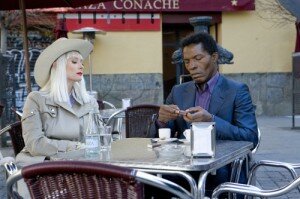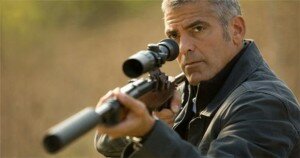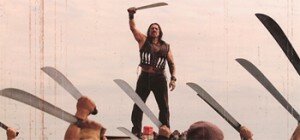Three Killers
Written by Ankan // November 2, 2010 // Media & Popular Culture // 4 Comments
The American (2010); dir. Anton Corbijn
Machete (2010); dir. Ethan Maniquis and Robert Rodriguez
The Limits of Control (2009); dir. Jim Jarmusch
At the end of the world, surrounded by snow and frozen lakes, a couple is suddenly attacked by an anonymous sniper. The man quickly takes charge of the scene by pulling out a gun, shooting the sniper and the girl he was with. He discovers another armed man and shoots him too. The sudden violence bursts through the glacial stillness of the setting. He then decamps to Italy.
George Clooney, with the help of several names like Jack and Edward, plays an enigmatic American who is probably an assassin on a mission in Anton Corbijn’s The American. In picturesque Italian villages he drives around, befriends a priest, builds a rifle with the magazine-capacity of a submachine gun on commission from an equally mysterious woman, works up a vague relationship with a prostitute and hurtles towards a cool and violent climax. He is assigned by a man called Pavel who calls him up with directions, although we don’t really understand, and neither does Clooney, what he is meant to do. The frames are pure, static and always quietly observant of Clooney’s actions. The austerity is only built up by constant ruptures like the one in the beginning. In another scene, the prostitute walks into the frame, suddenly and completely, naked; a similar sort of rupture.
Holed up in the village, he has half-baked conversations with the priest who attempts to stereotype him. When he confesses that he doesn’t know much about the history of the place, the priest, Father Benedetto, tells him “Of course… You’re American. You think you can escape history. You live for the present.” It’s a bit of a pretentious stab; or you might guess that Clooney is supposed to represent a cool and collected system that thrives on deceit and violence. He is also an agent who does not belong to this setting and his motivations are not visible to the people close to him. The heavy-handed attempts to connect Clooney’s character to complex geo-politics take a little bit away from the set up of the film. As if the makers could not fully trust the relevance of the pure, classical, formal exercise that is the real basis of the film. The exercise to break away from perfectly stitched plots where a mysterious stranger will eventually have to kill a recognizable giant, like Charles de Gaulle in The Day of the Jackal.
About halfway through the film, when Clooney is testing out the gun, a beautiful and endangered butterfly is introduced to the plot. Clooney has a butterfly tattoo on his back. As the credits roll, an aria from Madame Butterfly plays out. The American is the kind of film that tries to be smart, but ends up slightly smug and lacking. The film’s attempt to play with the form of an assassin movie is reminiscent of Jim Jarmusch’s UFO of a film from last year, The Limits of Control. It pushes way beyond Jarmusch’s earlier assassin-movie attempt (the brilliant Ghost Dog: The Way of the Samurai). In Ghost Dog, we had a similar assassin in Forest Whitaker; unsocial, lonely but guided by a fixed code: the samurai text on living like a dead man, Hagakure. In Limits of Control we have nothing. And the film spins out of this nothing and circles it, so that by the end we have an idea of the structure of the film, the firm lines that define the film, but not about what really keeps the film in place; a center. The center is, instead, constantly deflected by a wealth of references to classical art, literature, music, popular culture and movies; especially assassin movies like Boorman’s Point Blank and the blissfully Zen ones by Jean-Pierre Melville. It is so wildly vague and perfectly complete at the same time that it seems to be a bizarre parody on the act of beginning to think of a movie-plot.
An epigraph from Arthur Rimbaud introduces us to a journey that is dark, strange and unavoidable. The Assassin- titled only in the credits as The Lone Man (Isaach De Bankolé )- starts by taking vague instructions that sound like truisms on life at large and includes advice like “Use your skill and imagination”. Towards the end of the film, when he reaches his target (Bill Murray) by getting through what appeared to be an impregnable fortress, he only explains that he used his imagination. For the rest of the film, he follows the same ritual of meeting several people over two cups of espresso, admitting that he doesn’t speak Spanish, exchanging matchboxes and listening to the strange things his contacts have to say. He dresses impeccably, works out diligently like a samurai and refuses to sleep with a nude woman who appears as suddenly and violently as the prostitute (Violante Placido) in The American. The nude (Paz de la Huerta) also appears in another scene in a completely transparent raincoat. She wears nice black-rimmed glasses though. Other characters appear- all played by established actors like Gael Garcia Bernal, Tilda Swinton as a blonde woman with her skin seemingly starved of the sun and John Hurt cradling a guitar-case. Christopher Doyle’s cinematography is so beautiful that it frames the scenes like the paintings the Lone Man observes in the museum; like Juan Gris’ exaggerations, sharp definitions and bizarre edges: “slow deliriums in shifting light”, as Rimbaud puts it in Le Bateau ivre. The film encourages a wild chase around the obscure references, but what it ultimately puts out- and it definitely puts out- is a movie with plot points and character sketches that must be coloured in by the audience. In order to arrive at any stable center at the heart of this carefully controlled chaos, one must, like the Lone Man, use his imagination.
The way The Limits of Control and The American use similar ideas- sometimes almost similar scenes- to strip down the assassin movie to its essential elements, tells us also about the difference between the approaches. Unlike the determined approach in the frames of The Limits of Control, The American adopts both- the warm glow of the sun and brooding, crepuscular shades of the evening. Maybe there’s still some hope that Clooney’s assassin might change his ways and render this entire exercise unnecessary. The American is an attempt to forge the skeleton of The Limits of Control to the flesh of an excessive spectacle like Machete. And it falls somewhere in between.
For Robert Rodriguez’s new grindhouse feature, expanded from the fake trailer that accompanied Planet Terror and Death Proof, is trashy, tasteless and falls completely to the other end of the spectrum. Although it is suited more to the tradition of a revenge film, it uses the protagonist, Machete, played by Danny Trejo whose face looks like a boulder that has been hacked and picked at by centuries of exposure to sun, wind and rain, as an assassin for hire that complicates the plot and hurtles the film, once again, to a viciously violent climax. Machete embraces every cliché of a film of its kind and has fun indulging in them, and if you’re not already tired of this knowing, gratuitously violent brand of trash-art filmmaking, you will enjoy scenes where heads are separated from the body in quick, clean machete slices and people jump through windows holding on to another man’s intestines. It also has a scene where Lindsay Lohan appears nude in a church, then dresses up like a nun and guns people down. The actions and images are so obviously transgressive that it comes as a fierce assault on any attempt to infer, interpret or speculate. It treads on politics; the issue of the status of illegal workers/immigrants from Mexico to the United States and injustices meted out to them, but I wonder what anybody can learn from this take except for the fact that it is a complicated situation and needs the underground support of all illegal immigrants. It’s fun, but it throws up little else in the way of a challenge that was initially promised by Tarantino and Rodriguez when they released their double-bill Grindhouse feature. The machete is crude and wild, unlike the gun that Clooney makes.
Released around the same time, while The American is a cool and measured film that tries to walk on the edge between classical restraint and brutal violence, Machete comes across as a truckload of campy high jinks. But Jim Jarmusch’s masterpiece is very heaven, the chef-d’oeuvre and the real Lee Marvin.




4 Comments on "Three Killers"
Great post.
The assassin for hire genre has been done in so many interesting ways.
The great grand daddy of them all is of course Melville – and you can trace the influence down through John Woo (with a delightful melodramatic twist), Luc Besson and so many others. Ghost Dog to me is a great tribute to Melville and the Zen Assassin with the requisite Jarmusch quirkiness.
I wouldn’t consider Machete to be a assassin film – for it was simply a plot device, which could have been replaced with something far more interesting.
The other two I have not seen, though heard great things about The American.
Thank you, I have just been looking for information approximately this topic for
ages and yours is the greatest I’ve discovered till now.
However, what about the bottom line? Are you positive about the supply?
I know this site offers quality dependent
articles and extra data, is there any other web page which presents these things in quality?
This piece of writing is genuinely a pleasant one
it assists new internet users, who are wishing in favor of
blogging.